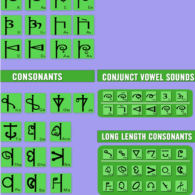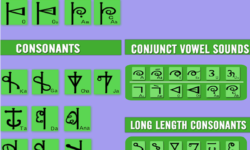Profile
Kammara is one of nearly twenty scripts created by Dr. Prasanna Sree for indigenous and minority groups, mostly in Andhra Pradesh. In each case, the design of the script reflects some iconic feature of the culture of that linguistic community. She writes:Kammara is spoken in the scheduled and adjoining areas of Srikakulam, Vizianagaram, Visakhapatnam East and West Godavari districts of Andhra Pradesh, India.
The Kammara people are also known as Konda Kammara or Ojas. Their population was 45,010 in the 2001 census, and in addition to their native language, many of them also speak Telugu.
Even though traditional occupation of Kammaras is blacksmithing and carpentry, most of them have given up their traditional occupations and started resorting to shifting and settled cultivation.
The Kammara tribe is divided into a number of totemic clans which regulate marital relations among the Kammaras. Some of the popular clans are Korra (Sun), Killo (Tiger), Bhalu (Bear), Samardi (flower), and Pangi (kite), and their surnames are identical with surnames of other tribal groups in Visakhapatnam district.
Marriage by mutual love and elopement, marriage by capture, marriage by service and marriage by negotiations are socially approved forms of acquiring mates. Both levirate and sororate are in vogue. Kammaras eat beef and pork.
Kammaras perform festivals like Chaitrapurab, Gangalamma Panduga, and crop ceremonies. They perform Dhimsa folk dance along with other tribal groups.
They have traditional tribal councils of their own which regulate the social life of the Kammaras and settle their disputes.
Kammaras have been living in symbiosis with other tribes of the area. They manufacture agricultural implements and supply them to other members of the village and receive in kind for their services.
The Kammara are traditionally farmers and blacksmiths, so the common design element for their alphabet is the crowbar.
You can help support our research, education and advocacy work. Please consider making a donation today.


